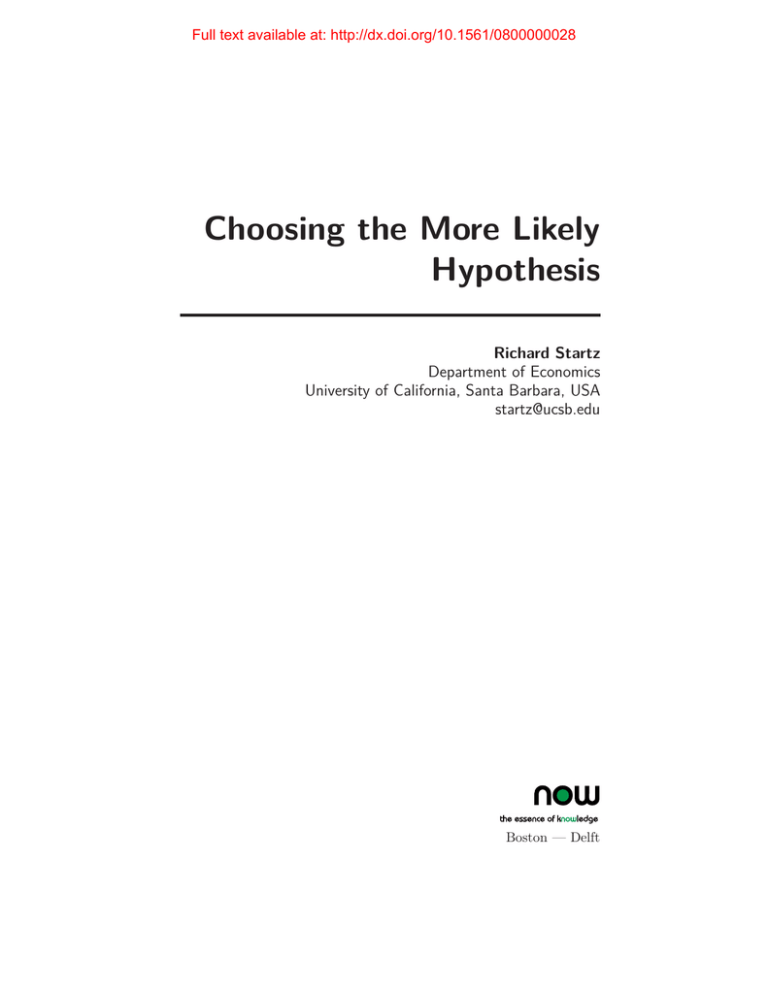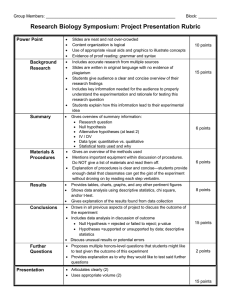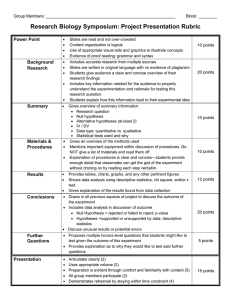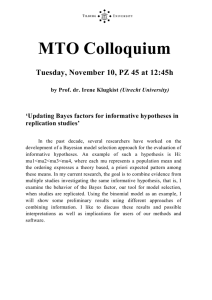
Full text available at: http://dx.doi.org/10.1561/0800000028
Choosing the More Likely
Hypothesis
Richard Startz
Department of Economics
University of California, Santa Barbara, USA
startz@ucsb.edu
Boston — Delft
Full text available at: http://dx.doi.org/10.1561/0800000028
R
Foundations and Trends
in Econometrics
Published, sold and distributed by:
now Publishers Inc.
PO Box 1024
Hanover, MA 02339
United States
Tel. +1-781-985-4510
www.nowpublishers.com
sales@nowpublishers.com
Outside North America:
now Publishers Inc.
PO Box 179
2600 AD Delft
The Netherlands
Tel. +31-6-51115274
The preferred citation for this publication is
R
R. Startz. Choosing the More Likely Hypothesis. Foundations and Trends
in Econometrics, vol. 7, no. 2, pp. 119–189, 2014.
R
issue was typeset in LATEX using a class file designed
This Foundations and Trends
by Neal Parikh. Printed on acid-free paper.
ISBN: 978-60198-899-7
c 2014 R. Startz
All rights reserved. No part of this publication may be reproduced, stored in a retrieval
system, or transmitted in any form or by any means, mechanical, photocopying, recording
or otherwise, without prior written permission of the publishers.
Photocopying. In the USA: This journal is registered at the Copyright Clearance Center, Inc., 222 Rosewood Drive, Danvers, MA 01923. Authorization to photocopy items for
internal or personal use, or the internal or personal use of specific clients, is granted by
now Publishers Inc for users registered with the Copyright Clearance Center (CCC). The
‘services’ for users can be found on the internet at: www.copyright.com
For those organizations that have been granted a photocopy license, a separate system
of payment has been arranged. Authorization does not extend to other kinds of copying, such as that for general distribution, for advertising or promotional purposes, for
creating new collective works, or for resale. In the rest of the world: Permission to photocopy must be obtained from the copyright owner. Please apply to now Publishers Inc.,
PO Box 1024, Hanover, MA 02339, USA; Tel. +1 781 871 0245; www.nowpublishers.com;
sales@nowpublishers.com
now Publishers Inc. has an exclusive license to publish this material worldwide. Permission
to use this content must be obtained from the copyright license holder. Please apply to
now Publishers, PO Box 179, 2600 AD Delft, The Netherlands, www.nowpublishers.com;
e-mail: sales@nowpublishers.com
Full text available at: http://dx.doi.org/10.1561/0800000028
R
Foundations and Trends
in Econometrics
Volume 7, Issue 2, 2014
Editorial Board
Editor-in-Chief
William H. Greene
New York University
United States
Editors
Manuel Arellano
CEMFI, Spain
Jan Kiviet
University of Amsterdam
Wiji Arulampalam
University of Warwick
Gary Koop
University of Strathclyde
Orley Ashenfelter
Princeton University
Michael Lechner
University of St. Gallen
Jushan Bai
Columbia University
Lung-Fei Lee
Ohio State University
Badi Baltagi
Syracuse University
Larry Marsh
University of Notre Dame
Anil Bera
University of Illinois
James MacKinnon
Queens University
Tim Bollerslev
Duke University
Bruce McCullough
Drexel University
David Brownstone
UC Irvine
Jeff Simonoff
New York University
Xiaohong Chen
Yale University
Joseph Terza
Purdue University
Steven Durlauf
University of Wisconsin
Ken Train
UC Berkeley
Amos Golan
American University
Pravin Travedi
Indiana University
Bill Griffiths
University of Melbourne
Adonis Yatchew
University of Toronto
James Heckman
University of Chicago
Full text available at: http://dx.doi.org/10.1561/0800000028
Editorial Scope
Topics
R
in Econometrics publishes survey and tutoFoundations and Trends
rial articles in the following topics:
• Econometric models
• Latent variable models
• Simultaneous equation models
• Qualitative response models
• Estimation frameworks
• Hypothesis testing
• Biased estimation
• Econometric theory
• Computational problems
• Financial econometrics
• Microeconometrics
• Measurement error in survey
data
• Treatment modeling
• Discrete choice modeling
• Models for count data
• Productivity measurement and
analysis
• Duration models
• Semiparametric and
nonparametric estimation
• Limited dependent variables
• Bootstrap methods
• Panel data
• Nonstationary time series
• Time series analysis
• Robust estimation
Information for Librarians
R
Foundations and Trends
in Econometrics, 2014, Volume 7, 4 issues. ISSN
paper version 1551-3076. ISSN online version 1551-3084. Also available as a
combined paper and online subscription.
Full text available at: http://dx.doi.org/10.1561/0800000028
R
Foundations and Trends
in Econometrics
Vol. 7, No. 2 (2014) 119–189
c 2014 R. Startz
DOI: 10.1561/0800000028
Choosing the More Likely Hypothesis1
Richard Startz
Department of Economics,
University of California, Santa Barbara, USA
startz@ucsb.edu
1
Portions of this paper appeared in an earlier working paper titled, “How Should
An Economist Do Statistics?” Advice from Jerry Hausman, Shelly Lundberg, Gene
Savin, Meredith Startz, Doug Steigerwald, and members of the UCSB Econometrics
Working Group is much appreciated.
Full text available at: http://dx.doi.org/10.1561/0800000028
Contents
1 Introduction
2
2 Choosing Between Hypotheses
6
3 Bayes Theorem
3.1 Bayes theorem applied to traditional estimators . . . . . .
3.2 Bayes theorem and power . . . . . . . . . . . . . . . . . .
3.3 Does the p-value approximate the probability of the null? .
10
10
12
14
4 A Simple Coin-Flipping Example
4.1 Point null and point alternative hypotheses . . . . . . . .
4.2 The probability of the null and the traditional p-value . . .
4.3 Choosing the null, the alternative, or remaining undecided
4.4 Implicit priors . . . . . . . . . . . . . . . . . . . . . . . .
4.5 The importance of the alternative . . . . . . . . . . . . .
4.6 A continuous alternative for the coin-toss example . . . . .
16
17
18
20
21
24
25
5 Regression Estimates
5.1 Uniform prior for the alternative hypothesis . . . . . . . .
5.2 Normal prior for the alternative hypothesis . . . . . . . . .
5.3 One-sided hypotheses . . . . . . . . . . . . . . . . . . . .
28
29
34
38
ii
Full text available at: http://dx.doi.org/10.1561/0800000028
iii
6 Diffuse Alternatives and the Lindley “Paradox”
41
7 Is the Stock Market Efficient?
44
8 Non-sharp Hypotheses
49
9 Bayes Theorem and Consistent Estimation
52
10 More General Bayesian Inference
10.1 Use of the BIC . . . . . . . . . . . . . . . . . . . . . . . .
10.2 A light derivation of the BIC . . . . . . . . . . . . . . . .
10.3 Departures from the Bayesian approach . . . . . . . . . .
54
54
55
59
11 The General Decision-theoretic Approach
11.1 Wald’s method . . . . . . . . . . . . . . . . . . . . . . . .
11.2 Akaike’s method . . . . . . . . . . . . . . . . . . . . . . .
61
61
63
12 A Practitioner’s Guide to Choosing Between Hypotheses
64
13 Summary
66
References
68
Full text available at: http://dx.doi.org/10.1561/0800000028
Abstract
Much of economists’ statistical work centers on testing hypotheses in
which parameter values are partitioned between a null hypothesis and
an alternative hypothesis in order to distinguish two views about the
world. Our traditional procedures are based on the probabilities of a
test statistic under the null but ignore what the statistics say about the
probability of the test statistic under the alternative. Traditional procedures are not intended to provide evidence for the relative probabilities
of the null versus alternative hypotheses, but are regularly treated as
if they do. Unfortunately, when used to distinguish two views of the
world, traditional procedures can lead to wildly misleading inference.
In order to correctly distinguish between two views of the world, one
needs to report the probabilities of the hypotheses given parameter estimates rather than the probability of the parameter estimates given the
hypotheses. This monograph shows why failing to consider the alternative hypothesis often leads to incorrect conclusions. I show that for
most standard econometric estimators, it is not difficult to compute the
proper probabilities using Bayes theorem. Simple formulas that require
only information already available in standard estimation reports are
provided. I emphasize that frequentist approaches for deciding between
the null and alternative hypothesis are not free of priors. Rather, the
usual procedures involve an implicit, unstated prior that is likely to be
far from scientifically neutral.
R
R. Startz. Choosing the More Likely Hypothesis. Foundations and Trends
in
Econometrics, vol. 7, no. 2, pp. 119–189, 2014.
DOI: 10.1561/0800000028.
Full text available at: http://dx.doi.org/10.1561/0800000028
1
Introduction
Much of economists’ statistical work centers on testing hypotheses
in which parameter values are partitioned between a null hypothesis
and an alternative hypothesis. In essence, we are trying to distinguish
between two views about the world. We then ask where the estimated
coefficient (or test statistic) lies in the distribution implied by the null
hypothesis. If the estimated coefficient is so far out in the tail of the
distribution that it is very unlikely we would have found such an estimate under the null, we reject the null and conclude there is significant
evidence in favor of the alternative. But this is a terribly incomplete
exercise, omitting any consideration of how unlikely it would be for us
to see the estimated coefficient if the alternative were true. Pearson
[1938, p. 242] put the argument this way,1
[the] idea which has formed the basis of all the . . . researches
of Neyman and myself . . . is the simple suggestion that the
only valid reason for rejecting a statistical hypothesis is
that some alternative hypothesis explains the events with a
greater degree of probability.
1
As quoted by Weakliem [1999a,b, p. 363].
2
Full text available at: http://dx.doi.org/10.1561/0800000028
3
The principle that the probability of a realized coefficient under
the alternative matters is at once well-understood and near-universally
ignored by economists. What is less appreciated is the practical point:
Our standard procedure of stating whether a coefficient is statistically
significant (or equivalently whether the hypothesized value of a coefficient lies outside the confidence interval, or equivalently whether the
p-value is small) can be a terribly misleading guide as to the odds favoring the null hypothesis relative to the alternative hypothesis. I give
examples below to show just how misleading our usual procedures can
be. Of course, for practice to change, there needs to be a better way to
conduct inference. I present alternative procedures that can be easily
implemented in our most common hypothesis testing situations.
My goal here is to offer a perspective on how economists should
choose between hypotheses. While some of the points are original, many
are not. After all, much of the paper comes down to saying “remember
Bayes theorem,” which has likely been around since Bayes [1763]; or
according to the delightful account by McGrayne [2011], at least since
Laplace [1774]. While it is entirely clear that economists do choose
between hypotheses using statistical tests as if Bayes theorem does not
exist, it is not because we have not been reminded of the danger of
such practice. It seems the advice didn’t take. Leamer [1983a,b] laid
out much of the argument in the very first volume of the Handbook
of Econometrics. McCloskey [1992] reports a discussion in which Ken
Arrow said, “Statistical significance in its usual form is indefensible.” In
an influential article in the medical literature, Ioannidis [2005] reminds
medical researchers “. . . the probability that a research finding is indeed
true depends on the prior probability of it being true. . . , the statistical
power of the study, and the level of statistical significance.” Kass and
Raftery [1995] offer some of the theory behind what’s said below. The
discussion in this monograph is at least foreshadowed in Pearson [1938]
and Arrow [1960] and parts are pretty explicit in Leamer [1978, 1983a]
and Raftery [1986a, 1995]. The hope is that by (a) giving blunt examples of the consequences of ignoring Bayes theorem and (b) offering very
easy ways to adjust frequentist statistics to properly account for Bayes
theorem, econometric practice may change more than it has in the past.
Full text available at: http://dx.doi.org/10.1561/0800000028
4
Introduction
This monograph is aimed primarily at the classical, frequentist,
econometrician who needs to choose between hypotheses. Most results
are illustrated in the context of the most simple econometric situation,
one where we have a normally distributed estimator, θ̂ ∼ N (θ, σθ̂2 ), and
a null hypothesis θ = θ0 versus an alternative θ = θ0 . The canonical
example is a test of a regression coefficient. There are five major points.
1. The traditional use of classical hypothesis testing to choose
between hypotheses leads to misleading results. As a practical
matter, standard practice can be very, very misleading. It is
entirely possible to strongly reject the null in cases where the
null is more likely than the alternative, and vice versa.
2. Choosing between hypotheses requires invoking Bayes theorem.
For the most common empirical applications at least, those where
the estimated coefficients are approximately normal, applying
Bayes theorem is very easy.
3. Once one acknowledges that one wants to compare a null hypothesis to an alternative, something has to be said about the likelihood of particular values of the parameter of interest under the
alternative. Use of Bayes theorem does require specifying some
prior beliefs. Sometimes this can be done in a way in which the
specified priors take a neutral stance between null and alternative; sometimes a completely neutral stance is more difficult.
4. The notion that frequentist procedures specify a null and then
take a neutral stance with regard to parameter values under the
alternative is wrong. Frequentist decision rules are equivalent to
adopting an implicit prior. The implicit prior is often decidedly
non-neutral.
5. Economic hypotheses are usually best distinguished by some
parameter being small or large, rather than some parameter being
exactly zero versus non-zero. Application of Bayes theorem permits the former, preferred, kind of hypothesis comparison by considering non-sharp nulls. The calculations required for choosing
between non-sharp hypotheses are straightforward.
Full text available at: http://dx.doi.org/10.1561/0800000028
5
All of this is, obviously, related to frequentist versus Bayesian
approaches to econometrics. This paper is addressed to the frequentist econometrician. Nothing addresses any of the philosophical differences between frequentists and Bayesians. Some Bayesian tools are
used, although these are really just statements of probability theory
and should be uncontroversial. A succinct statement of the goal of the
monograph is this:
After running a regression, the empirical economist should be able
to draw an inference about the probability of a null versus an alternative
hypothesis that is both correct and easy to make.
Full text available at: http://dx.doi.org/10.1561/0800000028
References
K. J. Arrow. Decision theory and the choice of a level of significance for
the t-test. In C. Olkin, M. Hoeffding, and Mann, editors, Contributions to
Probability and Statistics: Essays in Honor of Harold Hotelling. Stanford
University Press, Stanford, CA, 1960.
M. S. Bartlett. A comment on D.V. Lindley’s Statistical Paradox. Biometrika,
44:533–534, 1957.
T. Bayes. An essay towards solving a problem in the doctrine of chances.
Philosophical Transactions (Royal Society of London), 53:269–271, 1763.
K. P. Burnham and D. R. Anderson. Model Selection and Multimodel Inference: A Practical Information-Theoretic Approach. Springer, New York,
2nd edition, 2002.
G. Casella and R. L. Berger. Reconciling bayesian and frequentist evidence
in the one-sided testing problem. Journal of the American Statistical Association, 82(387):106–111, 1987.
M. H. Degroot. Doing what comes naturally: Interpreting a tail area as a
posterior probability or as a likelihood ratio. Journal of the American
Statistical Association, 68(344):966–969, 1973.
J. M. Dickey. The weighted likelihood ratio, linear hypotheses on normal
location parameters. The Annals of Mathematical Statistics, 42(1):204–
223, 1971.
J. M. Dickey. Is the tail area useful as an approximate bayes factor? Journal
of the American Statistical Association, 72(357):138–142, 1977.
68
Full text available at: http://dx.doi.org/10.1561/0800000028
References
69
A. C. Doyle. Silver Blaze. reprinted 1993 Oxford University Press, New York,
1893.
D. Firth and J. Kuha. Comments on ‘a critique of the bayesian information
criterion for model selection’. Sociological Methods & Research, 27(3):398–
402, 1999.
A. Gelman and D. B. Rubin. Evaluating and using methods in the social
sciences: A discussion of ‘a critique of the bayesian information criterion
for model selection’. Sociological Methods & Research, 27(3):403–410, 1999.
J. Geweke. Contemporary Bayesian Econometrics and Statistics. John Wiley
& Sons, Hoboken, NJ, 2005.
E. Greenberg. Introduction to Bayesian Econometrics. Cambridge University
Press, Cambridge, 2008.
J. A. Hausman. Specification tests in econometrics. Econometrica, 46(6):
1251–1271, 1978.
J. P. A. Ioannidis. Why most published research findings are false. PLoS
Medicine, 2(8):696–701, 2005.
R. E. Kass and A. E. Raftery. Bayes factors. Journal of the American Statistical Association, 90(430):773–796, 1995.
G. Koop. Bayesian Econometrics. John Wiley & Sons, 2003.
P. Laplace. Mémoire sur la probabilité des causes par les événemens. Savants
étranges, 6:621–656, 1774.
E. E. Leamer. Specification Searches: Ad Hoc Inference with Nonexperimental
Data. John Wiley and Sons, New York, 1978.
E. E. Leamer. Model choice and specification analysis. In Z. Griliches and
M. D. Intriligator, editors, Handbook of Econometrics, volume 1, pages 285–
330. North Holland Publishing Co., 1983a.
E. E. Leamer. Let’s take the con out of econometrics. American Economic
Review, 73(1):31–43, 1983b.
Y. Li, T. Zeng, and J. Yu. A new approach to bayesian hypothesis testing.
Journal of Econometrics, 178(3):602–612, 2014.
D. V. Lindley. A statistical paradox. Biometrika, 44:187–192, 1957.
D. N. McCloskey. The loss function has been mislaid: The rhetoric of significance tests. American Economic Review, 75(2):201–205, 1985.
D. N. McCloskey. Other things equal: The bankruptcy of statistical significance. Eastern Economic Journal, 18(3):359–361, 1992.
Full text available at: http://dx.doi.org/10.1561/0800000028
70
References
D. N. McCloskey and Stephen T. Ziliak. The standard error of regressions.
Journal of Economic Literature, XXXIV:97–114, 1996.
S. B. McGrayne. The Theory That Would Not Die: How Bayes’ Rule Cracked
the Enigma Code, Hunted Down Russian Submarines, and Emerged Triumphant from Two Centuries of Controversy. Yale University Press, New
Haven, CT, 2011.
J. Neyman and E. S. Pearson. On the problem of the most efficient tests
of statistical hypotheses. Philosophical Transactions of the Royal Society
of London. Series A, Containing Papers of a Mathematical or Physical
Character, 231:289–337, 1933.
E. S. Pearson. ‘Student’ as a statistician. Biometrika, 30:210–250, 1938.
D. Poirier. Intermediate Statistics and Econometrics. M.I.T. Press, Cambridge, 1995.
A. E. Raftery. Choosing models for cross-classifications. American Sociological
Review, 51(1):145–146, 1986a.
A. E. Raftery. A note on bayes factors for log-linear contingency table models with vague prior information. Journal of the Royal Statistical Society,
Series B, 48:249–250, 1986b.
A. E. Raftery. Bayesian model selection in social research.
Methodology, 25:111–163, 1995.
Sociological
A. E. Raftery. Bayes factors and BIC: Comment on ‘a critique of the bayesian
information criterion for model selection’. Sociological Methods & Research,
27(3):411–427, 1999.
G. Schwarz. Estimating the dimension of a model. The Annals of Statistics,
6:461–464, 1978.
H. Simon. Statistical tests as a basis for ‘yes-no’ choices. Journal of the
American Statistical Association, 40(229):80–84, 1945.
R. Startz. On the implicit uniform bic prior. Economics Bulletin, 34(2), April
2014.
A. Wald. Statistical Decision Functions. Wiley, New York, 1950.
D. L. Weakliem. A critique of the bayesian information criterion for model
selection. Sociological Methods & Research, 27(3):359–397, 1999a.
D. L. Weakliem. Reply to Firth and Kuha, Gelman and Rubin, Raftery, and
Xie. Sociological Methods & Research, 27(3):436–443, 1999b.
Full text available at: http://dx.doi.org/10.1561/0800000028
References
71
Y. Xie. The tension between generality and accuracy. Sociological Methods &
Research, 27(3):428–435, 1999.
S. T. Ziliak and D. N. McCloskey. The Cult of Statistical Significance. University of Michigan Press, Ann Arbor, MI, 2008.







